How Beer Glasses Impact Craft Beer’s Taste, Maximize Flavor and Experience.
Discover how the right beer glasses enhance and affect taste, aroma, and carbonation. Craft Brewers Elevate your brew with DVKSP’s guide to selecting right craft beer glassware.
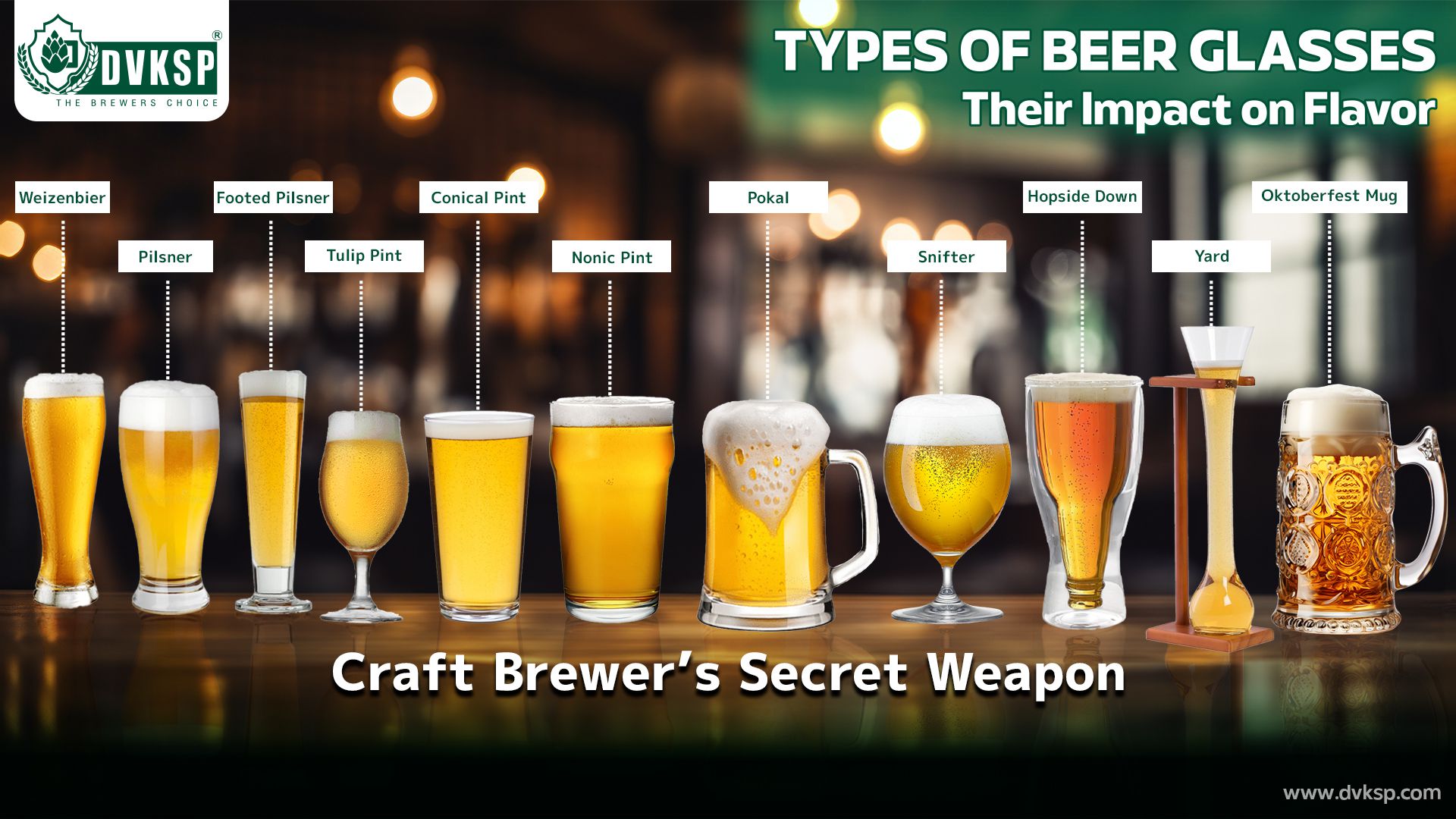
Types of Beer Glasses and Their Impact on Flavor: A Craft Brewer’s Secret Weapon.
Beer is more than just a drink—it’s an experience. And every craft brewer knows that beyond quality ingredients, presentation plays a key role in that experience.
At DVKSP, we supply the highest quality brewing ingredients but also believe in sharing the nuances that elevate a beer’s flavor.
Today, we’re diving into an often-overlooked detail that can significantly affect the flavor of your brew—the glass it’s served in.
For craft breweries & craft brewers, offering your customers the best beer experience involves not just great recipes but choosing the right beer glass.
The right glass enhances aromas, preserves carbonation, and elevates the entire tasting experience.
Here’s how different beer glasses can help craft brewers build a more memorable and enjoyable experience for their customers, boosting brand trust along the way.
Why Glassware Matters for Craft Breweries
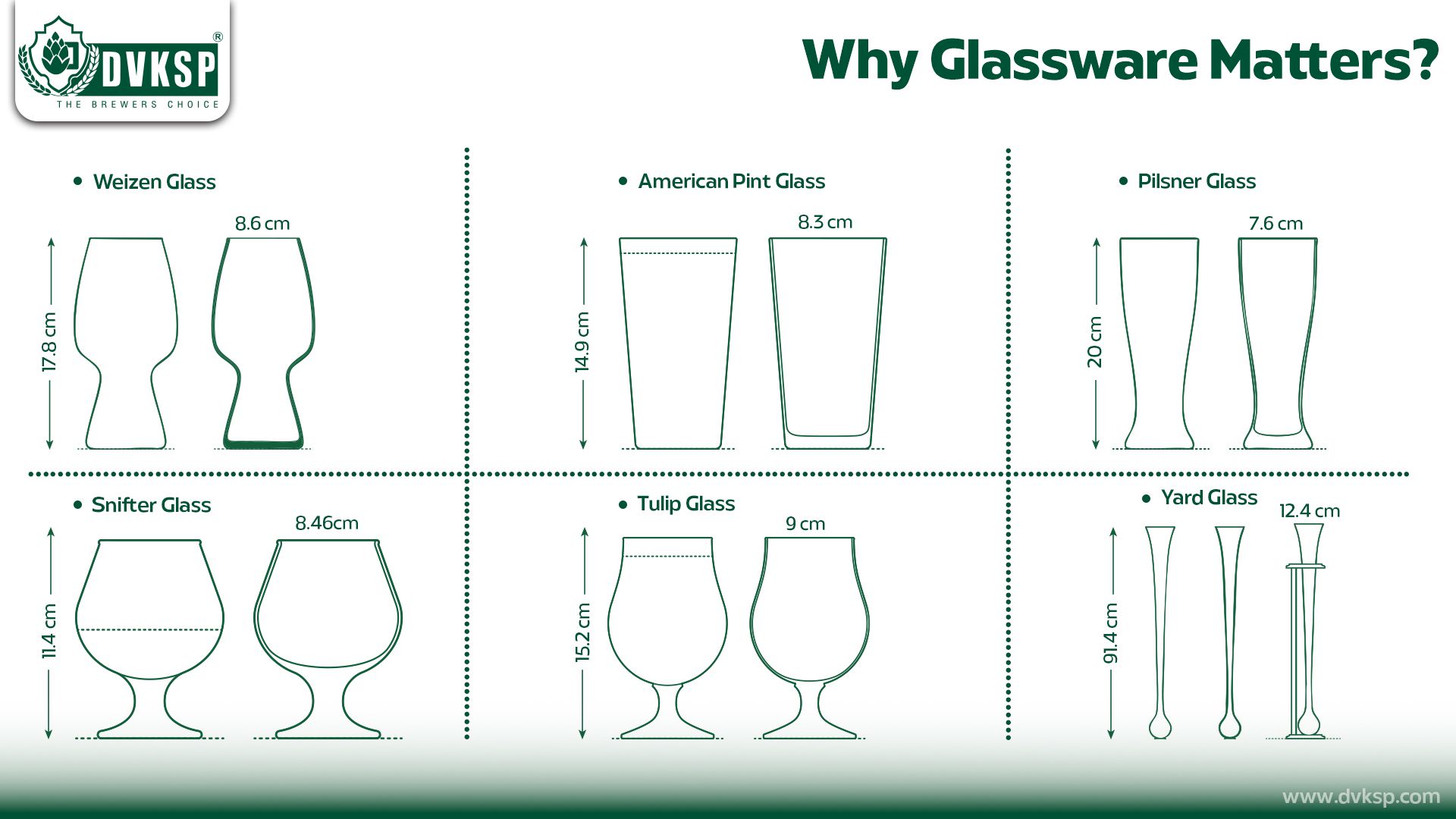
Different beer styles have different characteristics, and the glass they are served in should complement those traits.
Each glass is designed to highlight certain aspects of a beer, whether it’s enhancing its aroma, preserving its carbonation, or creating the perfect head.
The design of a beer glass is for more than aesthetics. Each glass type is tailored to enhance specific beer attributes, such as aroma, carbonation, and head retention.
The glass’s shape, size, and even thickness can affect how you perceive flavors and aromas. In essence, the right glass can elevate your beer-drinking experience to a new level.
For example, pint glasses are easy to use and versatile, but they do little to enhance a beer’s aroma.
On the other hand, tulip glasses are specifically designed to concentrate and enhance the smell of hoppy beers like IPAs.
DVKSP Tip: Understanding the science behind glassware helps craft brewers serve their beers in a way that showcases the hard work that went into brewing them. The right glass can also enhance the customer experience, making them feel like they’re enjoying something unique and special.
Enhancing & Building Customer Satisfaction & Trust Through Presentation

As a craft brewery, using the right glassware shows your customers that you care about their experience.
It’s these small details that make customers feel special and valued.
When you serve a beer in a glass that enhances its flavor, aroma, and appearance, you’re not just pouring a drink—you’re creating an experience.
Customers notice these things, and they’ll associate your brand with quality and care. This helps build trust and loyalty, which is crucial for any craft brewery looking to grow its customer base.
DVKSP Tip: Attention to detail, like using the right glass for each type of beer, shows your commitment to quality. It builds a connection with your customers, encouraging them to return again and again.
The Role of Aroma and Head Retention

Beer is a sensory delight, and much of its taste comes from its aroma. A well-designed glass helps concentrate the aroma, enhancing the overall flavor profile.
Additionally, some glasses are designed to preserve or promote head retention. This foam layer acts as a barrier, locking in the aromas and giving your taste buds the full flavor of the beer.
American Pint Glass – The Versatile Choice
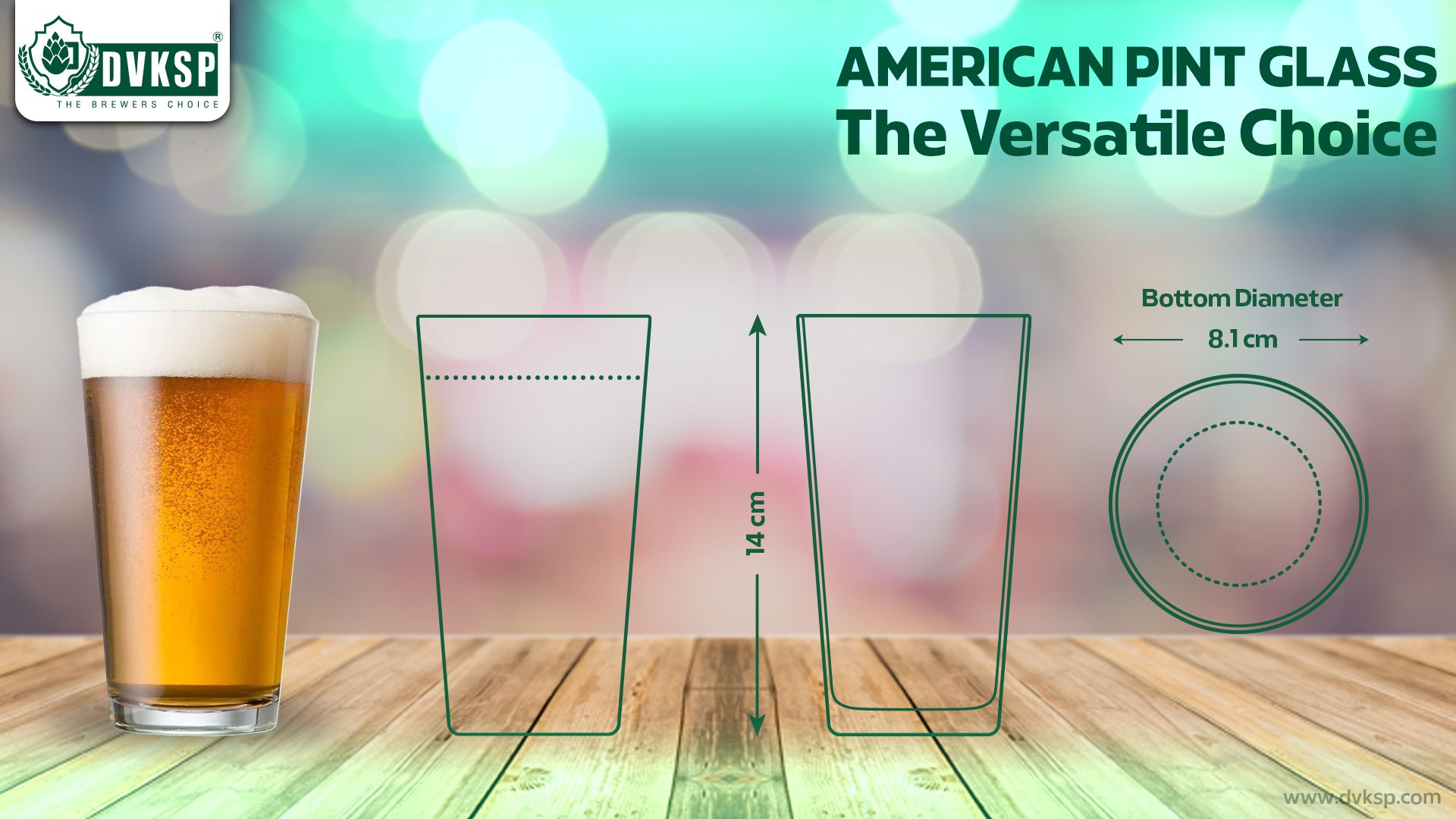
The American pint glass, also known as the conical pint, is one of the most common types of beer glasses. It’s versatile and can hold any beer style.
American Pint Glasses are Simple, Functional, but Lacks Flavor Enhancement
The wide mouth allows for easy drinking, but it doesn’t do much to concentrate the aroma.
This glass is perfect for casual drinkers who are not looking for anything too complex but want a quick and simple pour.
☑ Beer Styles Served in American Pint Glass: Multipurpose Beer Styles.
DVKSP Tip: Use an American pint glass for everyday beer styles like pale ales and lagers when you want a straightforward drinking experience.
Tulip (Belgian) Glass – Enhancing Aroma – The Go-To for Hoppy and Complex Beers
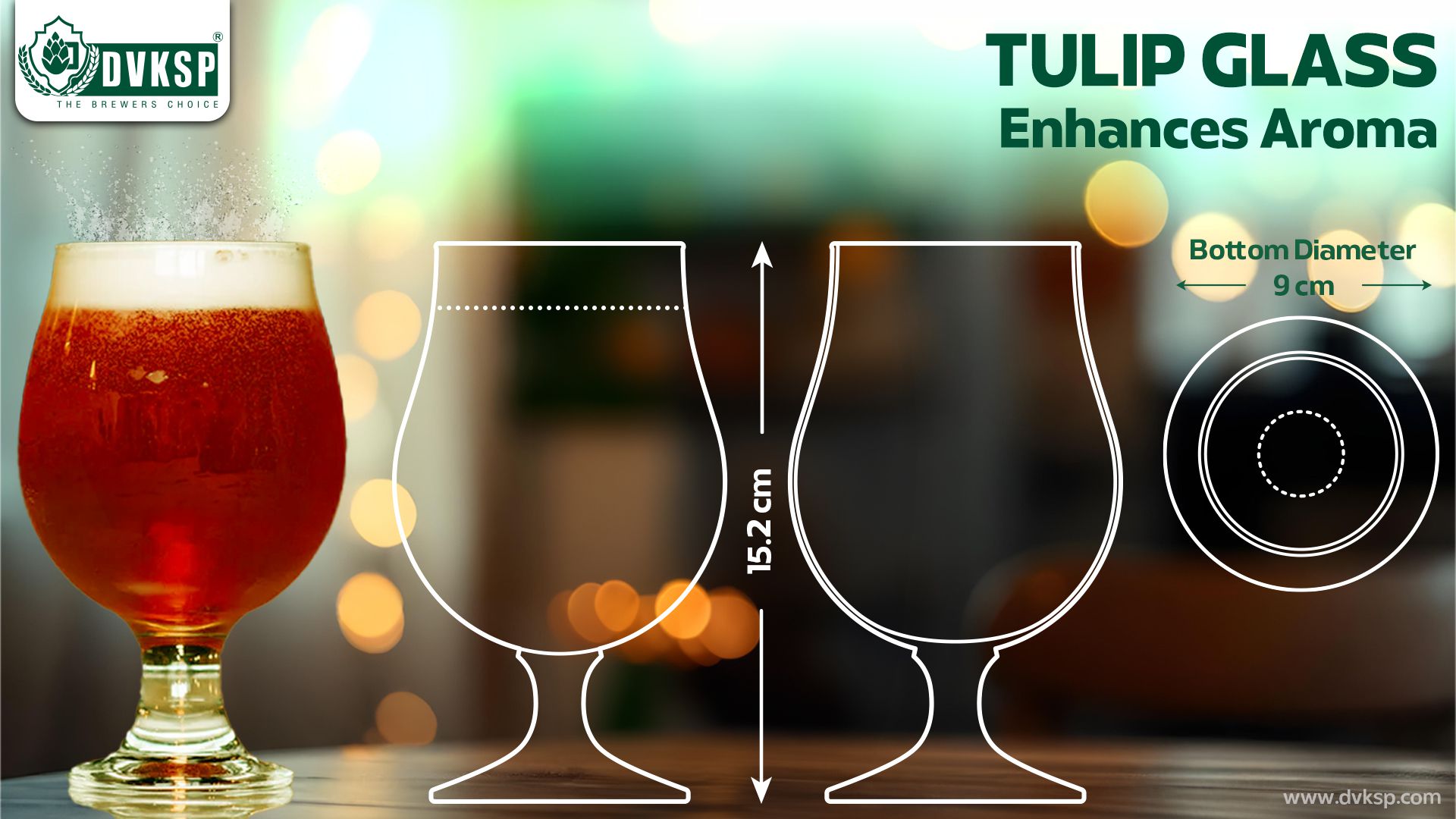
The Tulip Glass /Belgian Glass is designed for more aromatic and complex beers. Its rounded bowl allows the beer to be swirled, releasing volatile aromas.
The flared lip at the top helps capture and concentrate those aromas, making each sip a flavorful experience.
The Tulip glass is perfect for Belgian ales, IPAs, and other hop-forward beers.
The Science Behind Aroma Concentration of Tulip Glass:
A tulip glass narrows at the top, creating a funnel that directs the beer’s aromatic compounds straight to your nose.
The rounded bowl also encourages swirling, which releases more aromas. This interaction between shape and aroma is why the same beer can taste different in various glasses.
☑ Beer Styles Served in Tulip Glass/Belgian Glass: Scottish ales, Belgian ales, barleywines, saisons, gueuze, sour ales, wild ales.
DVKSP Tip: When brewing hoppy beers with DVKSP premium hops, serve them in a tulip glass to highlight the beer’s intense aroma.
Nonic Pint Glass aka Imperial Pint Glass: The British Classic Beer Glass.
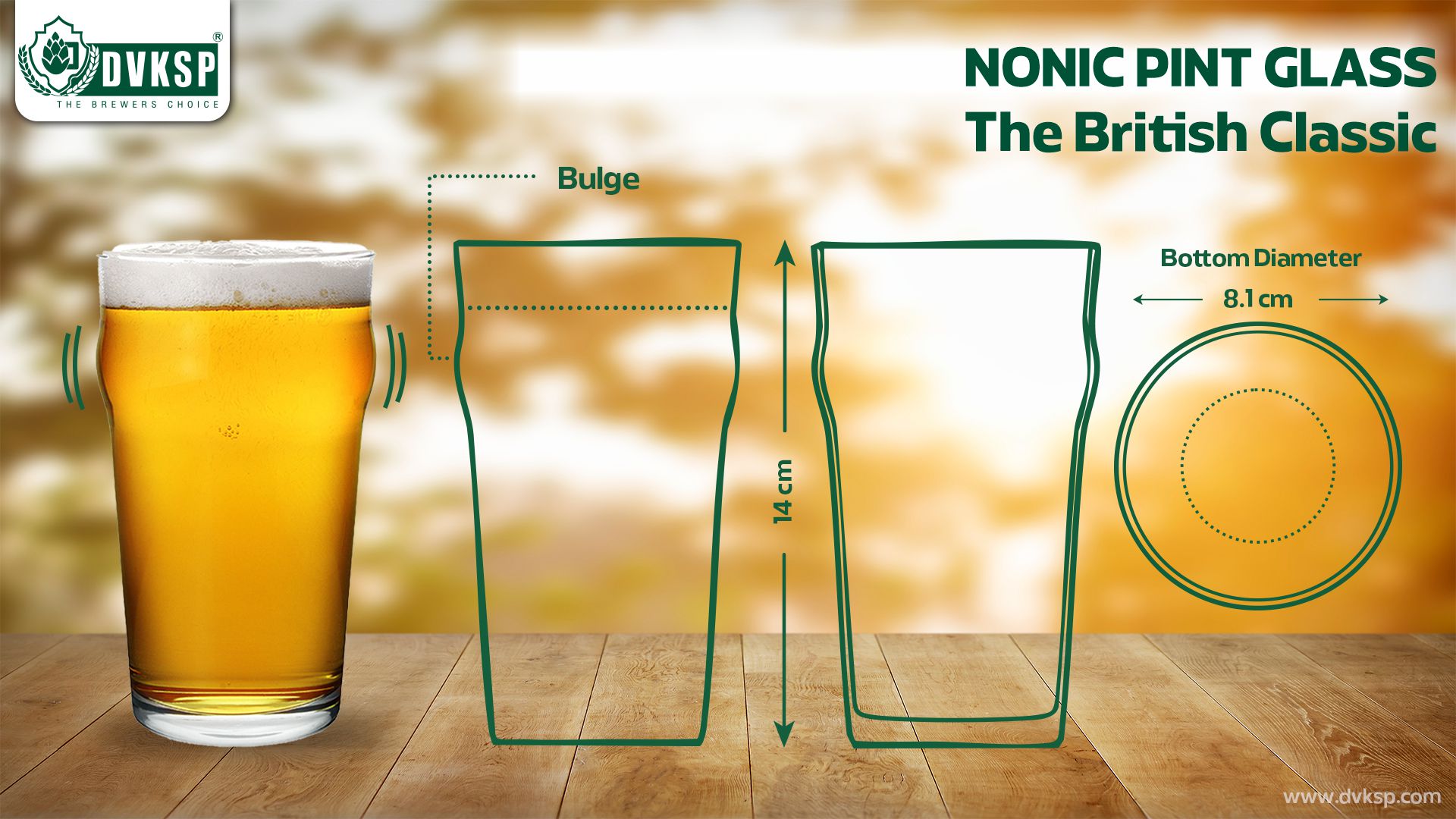
The Nonic pint glass is commonly used in the UK and is recognized by its distinctive bulge near the top.
This bulge not only makes the glass easier to hold but also helps prevent chipping when stacked.
Nonic pints are best for stouts, porters, and other dark ales. Their wide mouth allows for easy drinking and enhances the malty richness of the beer.
☑ Beer Styles Served in Nonic Pint Glass: English ales like bitters, pale ales, and dark milds
DVKSP Tip: Dark ales brewed with DVKSP’s specialty malts pair well with a Nonic pint, allowing for an easy, enjoyable drinking experience.
Pilsner Glass – Preserving the Effervescence – Showcasing Crisp, Clear Beers
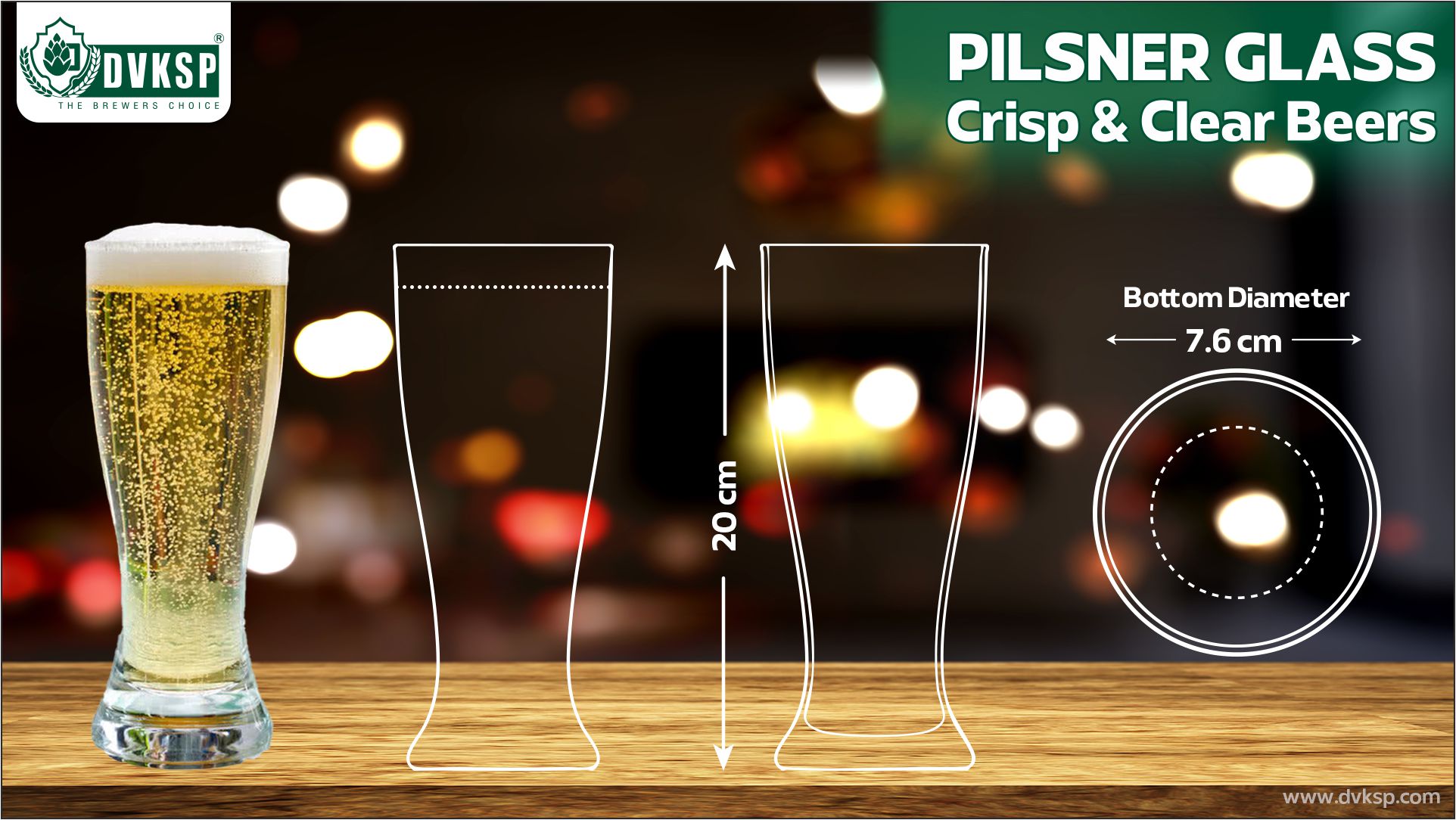
The pilsner glass is tall and slender, designed to highlight the crispness of light beers such as pilsners and lagers.
Its shape encourages the beer’s effervescence, allowing the bubbles to rise smoothly and creating a fluffy head that lasts longer.
The glass’s tall, narrow structure enhances the appearance of the beer’s golden hue, making it visually appealing.
☑ Beer Styles Served in Pilsner Glass: Pilsner, American adjunct lagers, bock, helles bock, maibock, Vienna lager, blonde ale, California common, Japanese rice lager, and witbier.
Why Beer Glass’s Shape Affects Craft Beer Carbonation
The narrow design of the pilsner glass helps maintain carbonation, keeping your beer fresh and lively.
The gentle slope of the glass also enhances the presentation of the foam, making each sip feel refreshing.
This makes the pilsner glass ideal for any beer where carbonation plays a key role.
DVKSP Tip: When brewing a light, refreshing pilsner with DVKSP’s specialty malts and Beer Brewing Yeast, serve it in a pilsner glass to accentuate its crisp, clean finish.
The Goblet – Perfect for Rich Beers
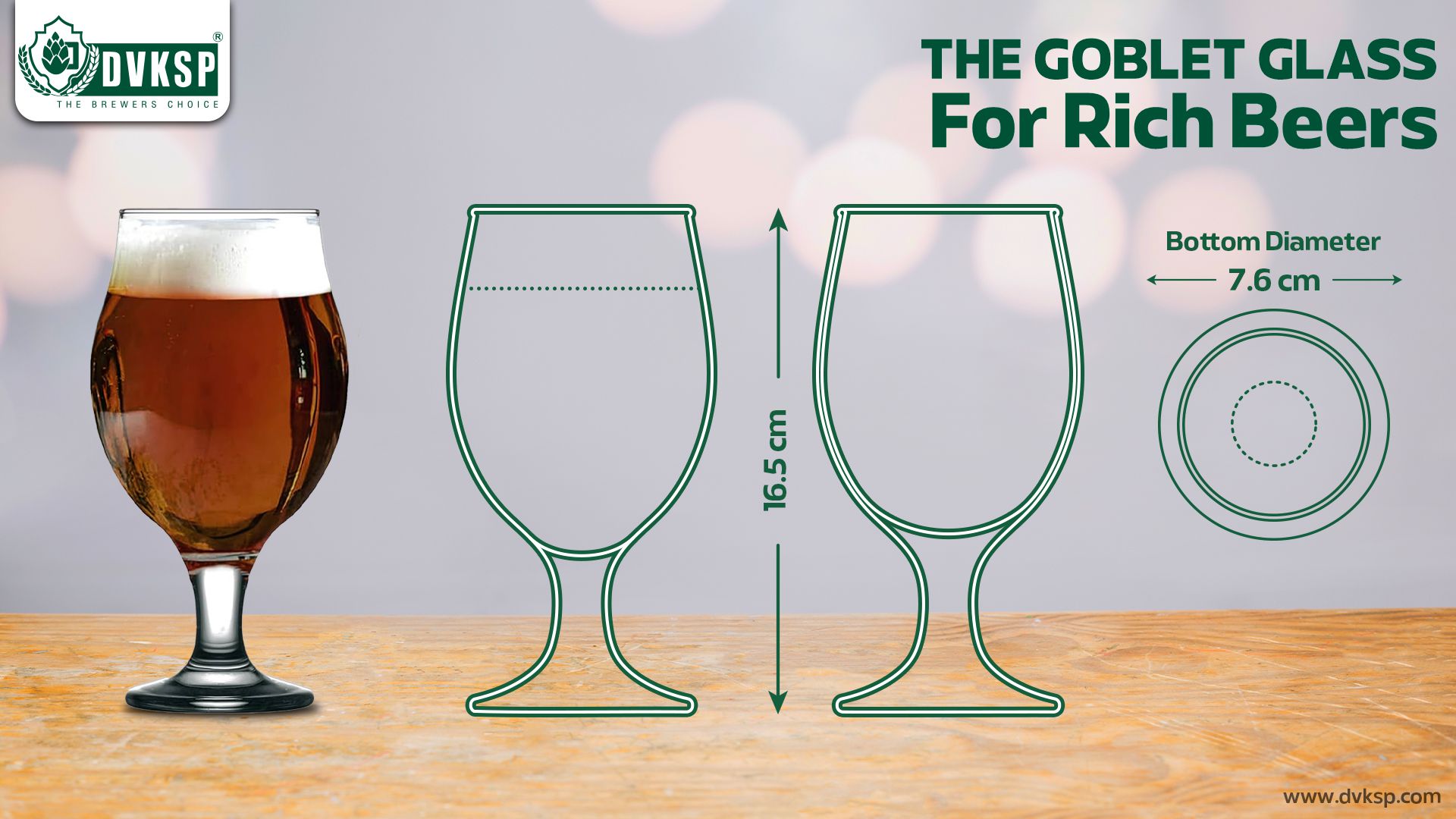
Goblets or chalices are heavy, thick glasses often associated with Belgian ales and Trappist beers. These glasses are designed to hold robust beers with high alcohol content.
The wide mouth allows for a large, foamy head, while the thick glass helps maintain the beer’s temperature longer.
The sheer weight of a goblet adds to the luxurious feeling of drinking a high-quality beer.
☑ Beer Styles Served in Goblet (Chalices) Glass: Heavy, dark beers like Belgian IPAs, Belgian strong dark ale, dubbel, tripel, and quadruples.
DVKSP Tip: When serving strong ales made with our premium malts and premium hops, consider using a goblet to amplify the richness and complexity of your brew.
The Weizen Glass – For Wheat Beers

The Weizen glass is tall and slender with a wide top, designed specifically for wheat beers.
This glass allows for a large head, which is essential for trapping the unique aromas of wheat beers, such as clove and banana.
The tall structure also helps to showcase the beer’s hazy appearance, making it an excellent choice for visually appealing wheat beers.
☑ Beer Styles Served in Weizen Glass: Wheat ale, dunkelweizen, hefeweizen, kristalweizen, weizenbock, and gose beers
DVKSP Tip: Serve wheat beers brewed with DVKSP’s specialty yeast in a Weizen glass to emphasize the fruity and spicy aromas.
Stange Glass – The German Tradition
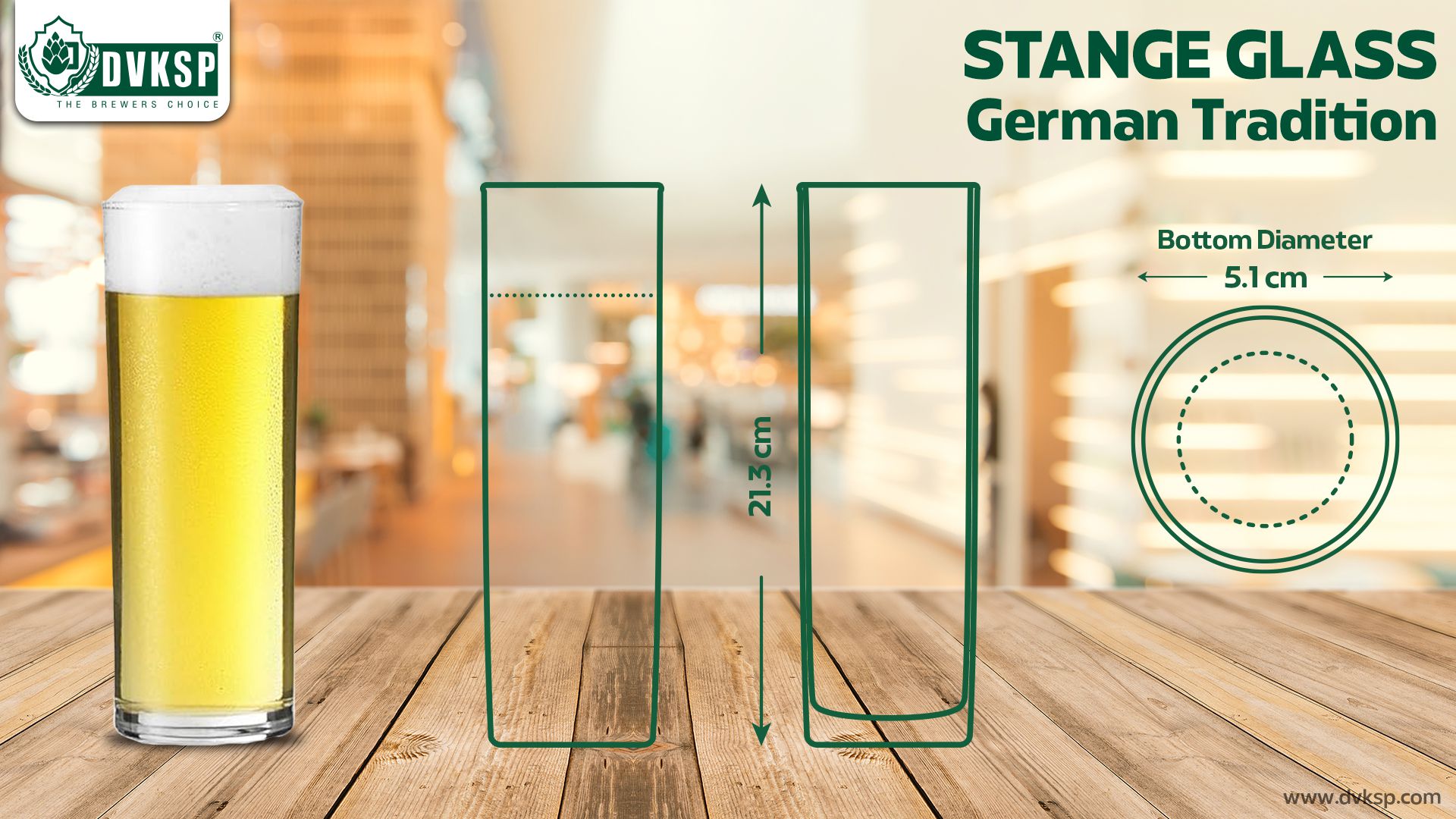
The Stange glass is a cylindrical, narrow glass used primarily for Kölsch beers.
Its tall and narrow shape helps maintain the beer’s delicate carbonation and aroma. This glass is often used in Germany and is perfect for showcasing lighter, more delicate beers.
☑ Beer Styles Served in Stange Glass: Kölsch, bocks, lambics, gose, Czech pilsners, rye beer, altbier, and rauchbier.
DVKSP Tip: When crafting light beers with our premium hops and premium malts, use a Stange glass to maintain the beer’s carbonation and crisp flavor.
How Beer Glasses Impact’s Craft Beer Taste Perception
The narrow shape of the Stange glass helps retain carbonation, while the small opening forces the beer to hit your tongue in a focused stream.
This concentrates the beer’s flavors, allowing you to enjoy even subtle notes.
Snifter Glass – For Complex, High-ABV Beers
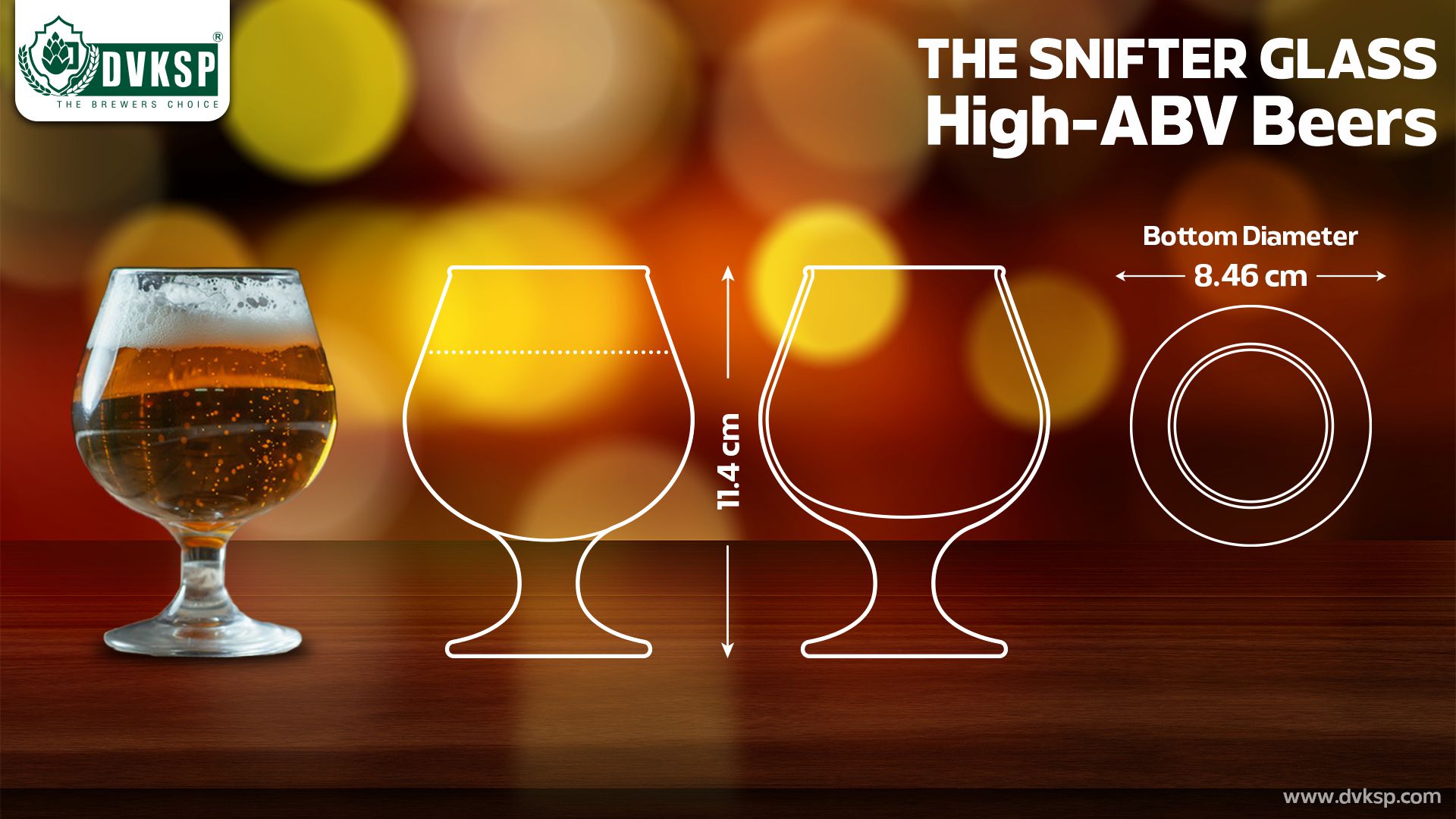
The snifter glass is typically reserved for strong, complex beers like barley wines and imperial stouts.
Its wide bowl and narrow opening allow for swirling, which releases the beer’s full aroma.
The glass is designed to be cradled in your hand, which gently warms the beer, further enhancing its complex flavors.
☑ Beer Styles Served in Snifter Glass: Barleywines, imperial IPAs, and Imperial stouts.
DVKSP Tip: High-alcohol beers brewed with DVKSP’s premium ingredients shine when served in a snifter, as the glass helps release the beer’s deep, nuanced flavors.
DVKSP’s Final Thoughts on Selecting and Elevating Your Beer with Right Beer Glassware
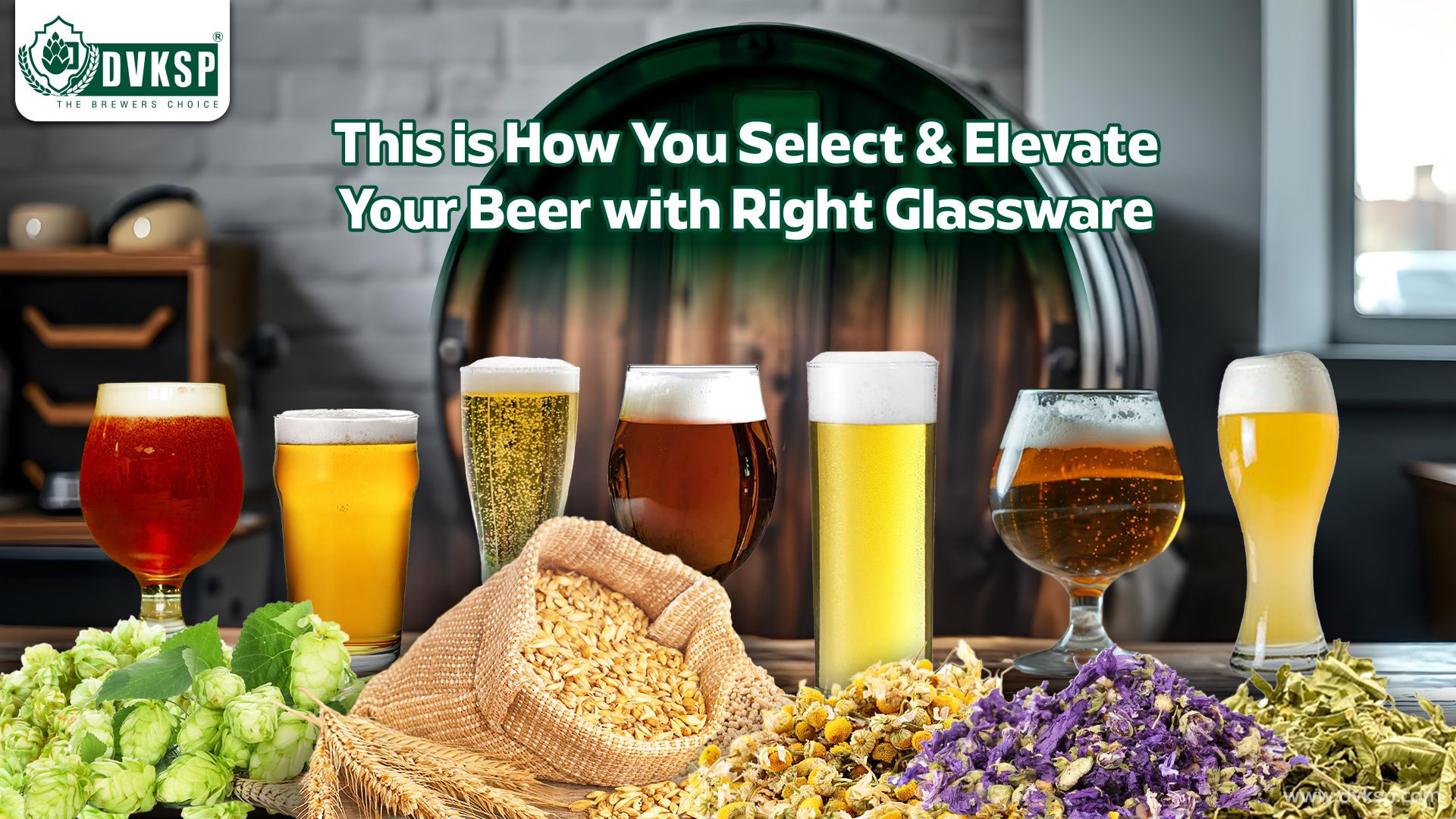
The next time you pour a beer, remember that the glass you choose is just as important as the ingredients.
The right glass can transform your beer from a simple drink into an unforgettable experience.
From aroma concentration to head retention and carbonation, each glass has its purpose.
Whether it’s the subtle notes of hops, the frothy head from premium yeast, or the malty richness, each glass shape plays a role in delivering the best possible beer experience.
At DVKSP, we believe that quality ingredients deserve the perfect presentation. Explore our wide range of brewing products and elevate your next brew with the perfect glass.
DVKSP is proud to provide brewers with premium ingredients that can stand up to any glass. Pair our high-quality malts, hops, yeast, and spices with the right beer glass to ensure your brew is always served at its best.
FAQs on Types of Beer Glasses, Beer Glasses Shapes & its Impacts on Craft Beer’s Taste, Flavor, and Drinking Experiences.
-
- Why do Beer Glasses matter at all in the first place?
Beer glasses enhance the aroma, taste, and visual appeal of craft beers, creating a complete sensory experience. - What is the purpose of using specific beer glasses of specific types of craft beer?
Using specific beer glass types enhances the aroma, flavor, carbonation, and presentation of different craft beer styles. - Which beer glasses are best for serving IPAs?
Tulip glasses and snifters are best for serving IPAs as they concentrate the aromas and maintain head retention. - What is the ideal glass for lagers and pilsners?
Pilsner glasses are ideal for lagers and pilsners as they showcase clarity, carbonation, and golden hues. - Why is a Weizen glass recommended for wheat beers?
Weizen glasses are designed to trap the foam and enhance the fruity and spicy aromas of wheat beers. - What type of glass should I use for stouts?
A snifter or a nonic pint glass is perfect for stouts as it enhances the rich, roasted flavors and aroma. - Can the shape of a beer glass impact the carbonation?
Yes, glass shapes with nucleation points (like tulip glasses) can affect carbonation and the beer’s head. - How does glass thickness affect beer drinking?
Thinner glass edges offer a smoother drinking experience, while thicker glasses retain temperature longer. - Are all-purpose beer glasses good for craft beers?
While all-purpose pint glasses are convenient, specific glasses enhance the experience of craft beer styles and their drinking experiences. - Why is head retention important in beer glasses?
Head retention maintains the beer’s aromas, adds a creamy texture, and protects the carbonation. - What is nucleation in beer glasses?
Nucleation refers to tiny etched points on glass that release carbonation, keeping beer fresh and fizzy. - Do beer glasses need to be chilled before use?
Chilling glasses can enhance the experience of lighter beers but may dull the flavors of darker beer styles. - What’s the best glass for Belgian ales?
Chalice or goblet glasses are ideal for Belgian ales as they amplify complex aromas and allow easy swirling. - Does the glass size matter for strong beers?
Smaller glasses, like snifters, are ideal for strong beers as they encourage sipping and intensify aromas. - How do etched beer glasses enhance the drinking experience?
Etched glasses promote continuous carbonation and keep the beer’s head intact for a longer time. - Can glass shape affect beer aroma?
Yes, narrower openings trap aromas, while wider openings enhance the release of complex beer scents. - Why are beer mugs preferred for casual drinking?
Beer mugs are durable, easy to hold, and great for casual drinking, especially for lagers and ales. - Is there a difference between craft beer and commercial beer glassware?
Craft beer glassware often focuses on enhancing specific styles, while commercial beer glassware emphasizes branding and practicality. - Can glass color affect beer enjoyment?
Yes, clear glasses highlight the beer’s appearance, while darker glasses are better for reducing light exposure. - What are the advantages of crystal beer glasses?
Crystal beer glasses are thinner and smoother, enhancing the overall drinking experience by reducing taste interference. - Should I wash beer glasses with soap?
Avoid soap residue on beer glasses as it can hinder head formation and alter the beer’s taste. - Why is proper glass care important for beer enthusiasts?
Proper glass care ensures the beer’s flavors, aromas, and carbonation remain unaltered for the best experience. - American Pint Glass is used for serving which style of Craft Beer?
You can use American Pint Glass for Serving Multipurpose Craft Beer Styles. - Tulip (Belgian) Glass is used for serving which style of Craft Beer?
You can use Use Tulip Glass aka Belgian Glass for serving Scottish ales, Belgian ales, barleywines, saisons, gueuze, sour ales, and wild ales Craft Beers. - Nonic Pint Glass aka Imperial Pint Glass is used for serving which style of Craft Beer?
You can use Nonic Pint Glass for serving English ales like bitters, pale ales, and dark mild Craft Beers. - Pilsner Glass is used for serving which style of Craft Beer?
You can use Pilsner Glass for serving Pilsner, American adjunct lagers, bock, helles bock, maibock, and witbier Craft Beers. - Goblet Glass or Chalices Glasses is used for serving which style of Craft Beer? You can use Goblet Glass for serving Heavy, dark beers like Belgian IPAs, Belgian strong dark ale, dubbel, tripel, and quadruple Craft Beers.
- Weizen Glass is used for serving which style of Craft Beer?
You can use Use Weizen Glass for serving Wheat ale, dunkelweizen, hefeweizen, kristalweizen, weizenbock, and gose Beer Styles. - Stange Glass is used for serving which style of Craft Beer?
You can use Stange Glass for Serving Kölsch, bocks, lambics, gose, Czech pilsners, rye beer, altbier, and rauchbier Craft Beers. - Snifter Glass is used for serving which style of Craft Beer?
You can use Snifter Glass for Serving Barleywines, Imperial IPAs, and Imperial Stouts Craft Beers. - Thistle Glass is used for serving which style of Craft Beer?
You can use Thistle Glass for Serving Scotch ale and wee-heavy Craft Beers.
- Why do Beer Glasses matter at all in the first place?



Leave a Reply
Want to join the discussion?Feel free to contribute!